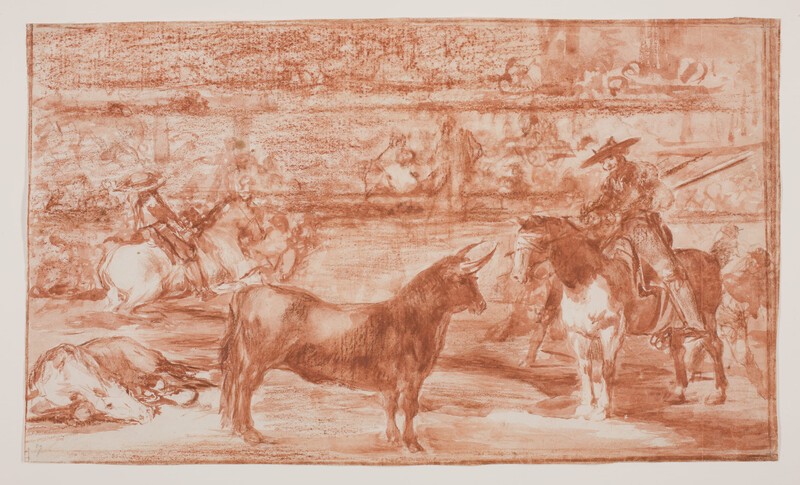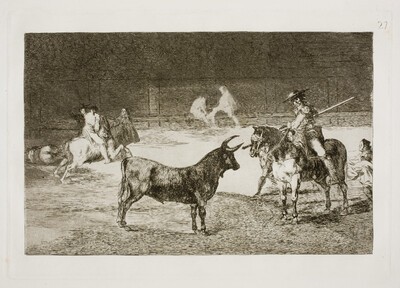- Cronología
- Ca. 1814 - 1816
- Ubicación
- The Prado National Museum. Madrid, Madrid, Spain
- Dimensiones
- 188 x 318 mm
- Técnica y soporte
- Reconocimiento de la autoría de Goya
- Documented work
- Titular
- El Prado National Museum
- Ficha: realización/revisión
- 02 Oct 2021 / 22 Jun 2023
- Inventario
- (D4314)
7 (in pencil, lower left corner)
See How the ancient Spaniards hunted bulls on horseback in the countryside.
This preparatory drawing passed by inheritance in 1828 to Javier Goya, the painter's son, and in 1854 to Mariano Goya y Goicoechea, the artist's grandson. It was subsequently owned by Valentín Carderera (ca. 1861) and Mariano Carderera (1880). In 1886 it was acquired from Mariano Carderera, along with many other drawings by Goya, including almost all the preparatory studies for the Bullfight, by the Directorate General of Public Instruction, and was assigned to the Prado Museum, where it entered on 12 November 1886.
See How the ancient Spaniards hunted bulls on horseback in the countryside.
Preparatory drawing of the print The famous Fernando del Toro, barilarguero, forcing the beast with his garrocha. This is the only preparatory study of the Bullfight in which red wash is used, which gives more movement to the scene, which almost resembles a watercolour, while at the same time darkening it, a darkening that in the engraving is achieved through aquatint.
The composition is still very full of different elements occupying the bullring, mainly people and horses, which is why it will be lightened when it is transferred to copper.
Goya may have seen this scene in the bullring in Saragossa when he was young. The bull stands out in the foreground, in profile, looking defiantly at the picador, Fernando del Toro, who stands in front of him. Behind the picador we can make out the figure of a man. On the left of the scene, still in the foreground, we see a horse on the ground that appears to be badly wounded. Behind it is another picador on horseback. In this case the equine seems to be bending his hind legs. Finally, in the background, the figures cannot be made out very well because they are too blurred, but there seem to be many of them. Most of them will disappear when they are transferred to the plate.
This drawing was pasted onto a second laid paper belonging to a French army record book in Spain.
-
Goya. Exposition de l’oeuvre gravé, de peintures, de tapisseries et de cent dix dessins du Musée duBibliothèque nationale de FranceParís1935cat. 273
-
Goya (1746-1828). Peintures-Dessins-GravuresCentre Cultural du MaraisParís1979consultant editors Jacqueline et Maurice Guillardcat. 77
-
Goya: Zeichnungen und DruckgraphikStädtische Galerie im Städelschen KunstintitutFrankfurt1981from February 13th to April 5th 1981
-
Goya: toros y torerosEspace Van GoghArles1990displayed also at Academia de Bellas Artes de San Fernando, Madrid, consultant editor Pierre Gassier.cat. 30
-
Goya en la Biblioteca Nacional. Exposición de grabados y dibujos en el sesquicentenario de su muerteBiblioteca NacionalMadrid1978May - June 1978cat. 275
-
Madrid2002
-
Madrid2005cat. IV
-
Goya: Luces y Sombras. Obras Maestras del Museo del PradoThe National Museum of Western ArtTokyo2011cat. 82
-
Barcelona2012cat. 59
-
Santander2017cat. 69
-
Madrid2019cat. 141
-
1946pp. 177-216, espec. p. 203
-
MadridMuseo del Prado1954cat. 180
-
1961pp. 120-127
-
ParísLe Club Français du Livre1963p. 123
-
Vie et ouvre de Francisco de GoyaParísOffice du livre1970p. 279, cat. 1205
-
Barcelona1974pp. 16-17
-
Dibujos de Goya, 2 volsBarcelonaNoguer1975pp. 388-389, cat. 269
-
El mundo de Goya en sus dibujosMadridUrbión1979pp. 205-206
-
MadridSilex1980pp. 156-157, cat. 53
-
MadridMuseo Nacional del Prado2001pp. 86-88
-
MadridMuseo Nacional del Prado2019pp. 222-223

